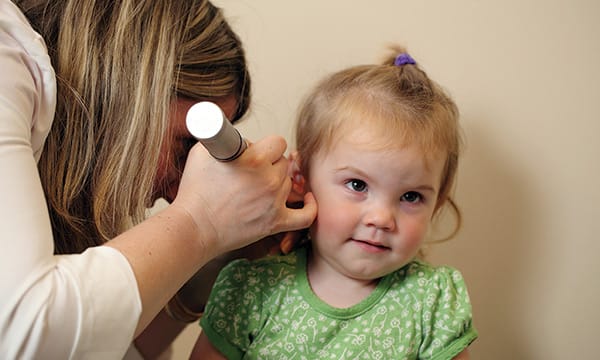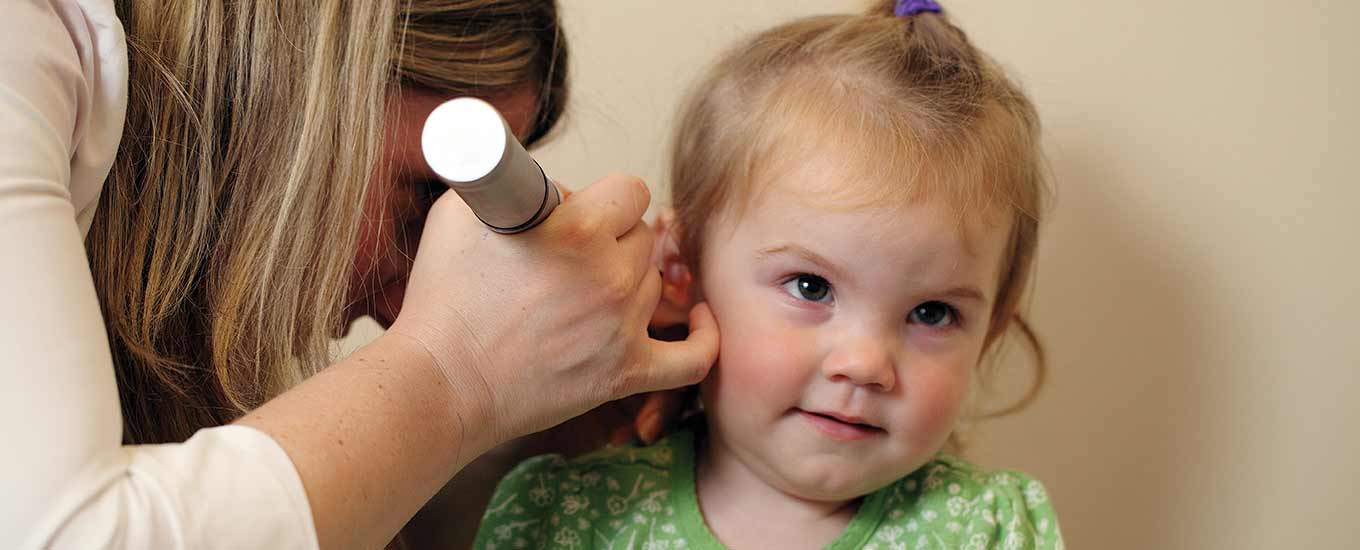Protect your kids’ hearing—before the damage is done
Like most new parents, Dr. Gillian Bonang is concerned with protecting her child’s health. But perhaps unlike most parents (although she serves as an excellent example), the Dartmouth-based audiologist takes steps to safeguard her baby’s hearing from noise-induced damage.
She may have more reason than some parents to be cautious; her spouse is a part-time musician who often performs in noisy environments. “People almost laugh at me when I take my infant into a noisy pub with giant ear muffs over her ears, but I think it’s better to be safe than sorry,” says Dr. Bonang as she bounces Dylan, her lively 21-month-old daughter, on her knee.
It’s easy for moms and dads to overlook the importance of hearing protection—perhaps because some noise-induced damage only reveals itself when people reach their 40s or 50s. But now, potential hearing loss in young people is being taken more seriously.

“Just about everything the iPod generation is exposed to makes noise, and we lead such noisy lives that every bit of exposure is potentially problematic,” says Dr. Bonang, who just completed her clinical doctorate in audiology from the University of Florida while working at a Dartmouth, NS, hearing clinic.
A sensitive sense
Human ears are vulnerable because the ability to hear depends on the health of many thousands of microscopic hairs, which grow on the surface of the cochlea, a spiral shaped chamber in the inner ear. At the cochlea, the tiny hairs convert sound vibrations into nerve signals, which are then transmitted along the auditory nerve and interpreted by the brain.
Noise causes hearing loss through direct mechanical damage to the hair cells, and through secondary metabolic damage, which involves the release of free radicals that may cause the hair cells to die.
Loud events like concerts, air shows and car races can result in sudden temporary or permanent hearing loss, but lesser sounds can also threaten hearing. The loss is often signified by tinnitus, or ringing ears.
“People don’t understand that it’s not just the level of sound,” Dr. Bonang says. “Hearing loss can be caused by an extremely loud, brief noise or by a very moderate level of noise, that persists. If a moderate sound is heard for long enough, it wears out the little hair cells on the cochlea to the point where they can’t recover, and they die.”
Continuous noise levels above 85 decibels can be damaging. Rock music at a concert is typically at a level of 110-120 decibels. Turned up to their fullest, headphones or earbuds from mobile music devices can emit sounds at levels up to 105 decibels into young ears.
We all suffer some hearing loss as we age. Famously, the Mosquito anti-loitering device, an electronic unit sometimes used to dissuade young people from loitering, emits an annoying high-pitched sound usually audible only to those aged 25 and younger. Some people are more susceptible to hearing loss than others, but most of us don’t know how susceptible we are until the damage has been done.
Parental control
Parents and caregivers need to be aware of noisy threats at each stage of a child’s life. In early childhood, the sharp sounds created by those colourful toys kids love can be risky. Some innocent-looking baby toys emit more than 100 decibels of noise.
Ideally, sounds emitted by toys should not exceed 80 decibels. Canadian standards stipulate that no toy can exceed 100 decibels. This is higher than other national standards, and higher than the level recommended by the World Health Organization. Even if a toy does not seem excessively noisy, parents should be vigilant, as a toy held close to the head can still cause hearing damage.
“Some toys can be really loud, especially if the toy is held at the opening to the ear canal,” Dr. Bonang says.
Adults should also supervise children when they use anything with a headset or microphone. “If the volume of the toy can be lowered, lower it. With an iPod, if there is an option to cap the level of sound—do that.”
Listening to loud music can affect hearing, depending upon how loud and how long the exposure. Every time a sound level increases by three decibels, listening for half as long will produce the same amount of hearing loss. A person listening to music on headphones should be able to hear people talking while the music is playing. Similarly, if you are not wearing the headphones but can hear what your child is listening to, the music is too loud.
Dr. Bonang says parents need to talk to older children about the importance of protecting their hearing. Kids should be made aware of the dangers posed by noise generated by big events like concerts. They should also realize that even things like cutting the lawn and solitary drumming can be risky. Of course, few teens are prepared to wear ear protection to any kind of social event.
There are a few basic types of hearing protection, including inserted ear plugs, which fully block the ear canal and ear protection muffs, with soft ear cushions and a hard outer shell. Luckily, foam earplugs offer a less visible solution, as do the high fidelity protective earplugs (also known as musicians’ earplugs) sold in music stores. These earplugs contain a filter that allows speech to pass through but diminishes background and excessive noise. Dr. Bonang’s husband Jeff, who plays guitar and harmonica, uses musicians’ plugs.
She says the plugs’ filters have different degrees of attenuation (reduction in noise level), usually offering attenuation of between nine and 25 decibels. Every plug has a noise reduction rating, but parents should realize that the plugs often don’t provide the advertised attenuation, simply because the ratings are based on optimal conditions and ideal fit.
It’s important to ensure that youngsters use earplugs correctly; to be effective, there should be an air seal between the ear plug and the skin. The foam plug should be compressed and the ear pulled up and back to straighten the ear canal, then the plug should be placed inside and allowed to expand.
Dr. Bonang suggests that parents take noise-obsessed teens for hearing assessments. The sessions can teach teens about those precious little hair cells and make them realize how vulnerable their hearing is.
A cautionary tale
Drums are a popular instrument among musical kids who often vie for the coveted role of drummer when they begin band classes. Halifax performer and music teacher, Rob Francis suffered hearing loss in his left ear as a result of ignoring his own parents’ warnings about noise. Now 42, Francis makes sure to teach his students and their parents about hearing protection.
Drumming doesn’t have to be deafening; loudness depends on how fiercely the drums are hit and the softness or hardness of the skins that cover them, but Francis aims to make kids aware of the dangers.
“I tell them it’s no different to using a jackhammer without protection,” he says. “I tell them about my hearing loss. It’s a bit of a scare tactic. Their eyes get big—they don’t want that to happen to them.”
The musician, who plays with a band, started drumming at age nine, after being inspired by The Ventures’ tune, Wipeout. His dad, Gordon, an accomplished amateur musician, encouraged his son to protect his ears with his own bulky earmuffs, which he wore for his work in construction. But young Rob only wore the earmuffs when his dad was around.
“I didn’t listen,” he says. “I felt that I couldn’t hear what I was playing with them on, and I was a little rebellious.”
He went without ear protection when jamming with high school friends too. Then, in his 20s, he noticed a persistent ringing in his left ear, which he still suffers. An audiologist confirmed he had become deaf to high-pitched sounds in that ear. The damage was doubtless caused by the fact the right-handed drummer always placed his snare drum to his left and turned his head slightly to the right. “Now,” he says, “everything sounds muffled.”
Today when he’s performing, Francis wears in-ear monitors. The monitors, which have limiters, connect to the soundboard and allow him to control the volume. At $500, the monitors are not cheap, but Francis says that for young drumming students, the regular foam earplugs, or earmuffs like those worn for yard work, offer sufficient protection.
Improvements in testing
The importance of good hearing to child development is increasingly being recognized. Newborn hearing screening is becoming more common as pediatricians realize parents may not always be able to spot early hearing difficulties in their child.
According to the Nova Scotia Hearing and Speech Centres, early identification and intervention with hearing and speech-language disorders are directly linked to success with vocabulary, speech-language development, school readiness and achievement.
To assess a baby’s hearing, pediatricians measure the sounds created by the hairs on the cochlea in response to sound, using what is known as the otoacoustic emissions test. The test measures an acoustic response that is produced by the cochlea, which, in essence, bounces back out of the ear in response to a sound stimulus.
Gillian Bonang says it’s good news that health professionals are recognizing the importance of testing and protecting children’s hearing. Statistics support her concern: according to experts quoted by the Children’s Hearing Institute, the number of Americans aged three and older with a hearing disorder has more than doubled since 1971.
But Francis says the parents he meets still have a long way to go in terms of educating themselves to prevent hearing loss in their kids—particularly those kids who are drummers.
“Not even 10 per cent of parents ask me about protecting their child’s hearing from noise,” he says, “but I tell the kids, ‘If you’re going to blast it out, keep your ears protected.’ I should have taken better care.”
